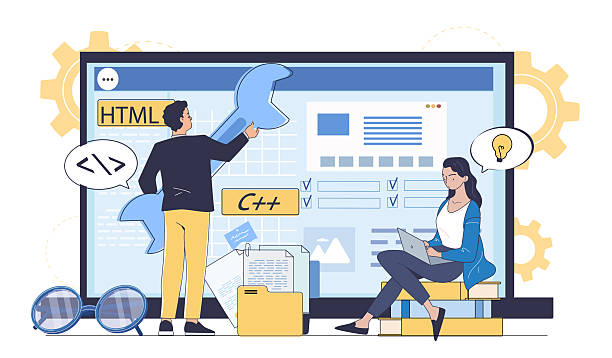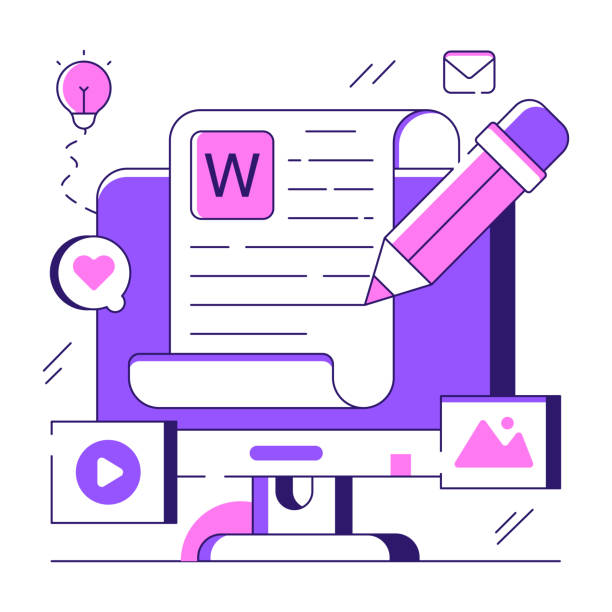Introduction to the Importance of Rapid Website Design in the Digital Age

In today’s fast-paced world, speed is paramount.
#Users expect websites to load in a fraction of a second and provide a flawless user experience.
This is where the concept of rapid website design becomes more important than ever.
You can no longer survive in the digital competition with a slow and inefficient website.
The loading speed of a website not only affects the direct visitor experience but is also an important factor in search engine rankings like Google.
A slow website drives users away and drastically reduces conversion rates, while an optimized and fast website can attract more potential customers and convert them into loyal clients.
This issue is vital not only for large businesses but also for startups and small businesses.
Imagine a user searching for a product or service you offer; if your site loads with a delay, the user will most likely leave your page and go to a competitor’s site.
Therefore, investing in website speed optimization is a strategic step for any business aiming to succeed online.
In this article, we will provide a comprehensive explanation of the various aspects of designing and developing a high-speed website.
From technical aspects to its effects on marketing and SEO, we cover everything you need to know so you can confidently move towards designing your website with a focus on speed.
This is an essential need, not a luxury option, to ensure your business doesn’t drown in this vast ocean of information and competition.
Does your current corporate website not reflect your brand’s credibility and power as it should? Rasaweb solves this challenge for you with professional corporate website design.
✅ Increase visitor credibility and trust
✅ Targeted attraction of more customers
⚡ Click for free consultation!
Why is Website Speed Vital for Your Business?

Website speed is the backbone of #User_Experience and #Online_Success.
In today’s world, where users seek instant gratification, even a one-second delay in loading can mean losing a customer.
Studies have shown that if a website doesn’t load within 3 seconds, more than half of users abandon it.
This concerning statistic is a serious warning for any business with an online presence.
But why is rapid website design so important?
Firstly, it directly impacts User Experience (UX).
A slow site not only causes frustration but also conveys a sense of unprofessionalism to the user.
Users prefer smooth and responsive sites that they can easily navigate.
Secondly, site speed is a key factor in #SEO (Search Engine Optimization).
Search engines like Google rank faster websites higher because these websites provide a better user experience.
This means that if your site is slow, the likelihood of it being seen in search results decreases, and this directly affects your incoming traffic and ultimately your sales.
Thirdly, it directly affects the Conversion Rate.
Numerous studies have shown that even a small increase in loading speed can significantly boost the conversion rate.
The faster your site is, the more likely users are to complete purchase steps, registrations, or form submissions.
Finally, website speed also contributes to your #Reputation and #Branding.
A brand committed to providing quality services and an excellent experience cannot have a slow website.
Website speed optimization is not just a technical measure but also a powerful marketing strategy that helps you stand out in today’s competitive market.
Therefore, rapid website design is an essential investment for the future of your business.
Key Factors Influencing Website Speed

To achieve rapid website design, understanding the factors influencing loading speed is essential.
These factors include technical and content aspects, each of which can play a significant role in improving or decreasing site speed.
#Image_optimization is one of the most important of these factors.
High-volume images can severely reduce loading speed.
Using appropriate formats (like WebP) and compressing images without losing quality is a vital step.
#Optimized_and_clean_coding is also of high importance.
CSS, JavaScript, and HTML code should be minified, and unnecessary elements should be removed to reduce file sizes.
Using a #Content_Delivery_Network (CDN) also has a significant impact on speed.
A CDN drastically reduces response time by caching your site’s content on servers closer to users.
Also, choosing suitable and powerful hosting is another essential factor.
Shared hosting with limited resources can compromise your site’s speed, whereas cloud hosting or dedicated servers offer better performance.
Caching, or temporary data storage, also helps with page loading speed.
By enabling caching, users’ browsers can store some site information locally, eliminating the need to reload all information from the server on subsequent visits.
Below is a comparative table of key factors and their impact on site speed, so you can plan better and move towards rapid web development.
These factors together complete the puzzle of a website’s speed, and neglecting any one can lead to slowness and user dissatisfaction.
This specialized section helps you approach technical issues with a more comprehensive view and act smarter on the path to rapid website design.
| Factor | Description | Impact on Speed |
|---|---|---|
| Image Optimization | Compression and use of modern formats (WebP) | Very High |
| Code Minification (CSS, JS, HTML) | Removal of extra characters and file compression | High |
| Use of CDN | Content distribution on servers close to users | Very High |
| Suitable Hosting | Selection of powerful servers with high bandwidth | Very High |
| Caching | Temporary data storage in the user’s browser | High |
| Reduce Redirects | Minimizing extra transfers between pages | Medium |
| Font Optimization | Using optimized web fonts with optimal formats and loading | Medium |
Website Speed Measurement and Improvement Tools

After understanding the importance and factors affecting speed, the next step is precise #website_performance_measurement.
Without proper tools, speed improvement can turn into guesswork.
Fortunately, many powerful and free tools are available to help you identify speed bottlenecks and plan for rapid website design.
Google PageSpeed Insights is one of the most well-known and widely used of these tools.
This tool not only shows your website’s speed score on desktop and mobile but also provides specific suggestions for performance improvement, including image optimization, eliminating render-blocking resources, and enabling compression.
Another tool that is very useful in the field of building high-speed websites is GTmetrix.
GTmetrix provides more comprehensive reports, including a Waterfall Chart to visualize the loading order and timing of each resource.
This chart helps you visually understand which elements require the most loading time.
WebPageTest is also a more specialized tool that allows testing from different geographical locations and with various browsers, providing a deeper insight into the actual site performance under different conditions.
Regular use of these tools is an important part of the #speed_optimization process.
This is a practical guide that allows you to track your progress and ensure that the implemented changes truly lead to speed improvements.
Learning how to interpret the results of these tools and implement their suggestions is an essential skill for anyone looking for rapid website design and online success.
Don’t forget that speed improvement is an ongoing process, not a one-time action.
This educational section helps you move towards excellent performance with a correct understanding of speed metrics.
Does your current e-commerce website design not generate the expected sales for you?
Rasaweb is an expert in professional e-commerce website design!
✅ An attractive and user-friendly website aimed at increasing sales
✅ High speed and security for an ideal shopping experience⚡ Get free online store design consultation with Rasaweb!
Backend Optimizations for Fast Performance

Website speed is not limited to appearance and front-end; #backend_optimization also plays a vital role in rapid website design.
The backend includes the server, database, and server-side logic that processes data and generates web pages.
An inefficient backend can slow down even the fastest front-end.
One of the first steps is optimizing server-side code.
Ensuring that codes are written efficiently and database operations are performed quickly is essential.
Using modern frameworks and keeping server-side programming languages (such as PHP, Python, Node.js) up-to-date significantly helps improve performance.
#Database_optimization is also very important.
Inefficient queries, inappropriate indexes, and large data volumes can increase server response time.
Using proper indexes, optimizing queries, and removing unnecessary data improves database performance.
Additionally, implementing server-side caching mechanisms (like Redis or Memcached) to store frequently used query results or dynamic content can significantly reduce response time.
This is a specialized step towards creating an agile website.
Using Output Caching at the server level can also be beneficial.
This method stores the complete output of a web page after the first request and delivers the cached version on subsequent requests instead of reprocessing.
This analytical approach helps you understand the depth of performance issues and apply fundamental and powerful solutions for rapid website design.
Don’t forget that a powerful and optimized backend is the backbone of your website’s speed, and paying attention to it is as vital as the front-end.
Front-End Optimization Techniques for More Speed

Just as the backend is important, the #front_end also plays a key role in rapid website design.
The front-end includes all elements that the user sees in their browser, including HTML, CSS, JavaScript, images, and videos.
Optimizing this section directly impacts user experience and initial loading speed.
One of the most important techniques is #Minification of CSS and JavaScript files.
This process involves removing extra characters like spaces, comments, and new lines, which reduces file sizes and speeds up loading time.
#Gzip_compression is also a technique that reduces the size of text files (HTML, CSS, JS) before sending them to the browser.
This allows data to be transferred faster from the server to the client.
Also, image optimization is crucial.
Using modern image formats like WebP, compressing images without noticeable quality loss, and lazy loading images (loading images only when the user scrolls to them) can significantly improve initial loading speed.
High-speed website design requires attention to front-end details.
Reducing HTTP requests is another important solution.
Each file (image, CSS, JS) requires a separate HTTP request.
By combining CSS and JavaScript files (or using CSS sprites for small images), the number of requests can be reduced.
Furthermore, using optimized web fonts and loading them in a way that doesn’t block page rendering is also important.
Front-end optimization is an art and a science, and by combining these techniques, significant results in #web_speed can be achieved, providing a flawless user experience.
This is a comprehensive guide to reach peak performance on the path to rapid website design.
Choosing the Right Hosting: A Fundamental Step in Rapid Website Design

The importance of #hosting in rapid website design is often overlooked, but the truth is that your website’s hosting server is the foundation of its speed and performance.
Even if you have performed all front-end and backend optimizations, weak hosting can negate your efforts.
Choosing the right hosting depends on your needs and budget, but there are some general principles that should be observed.
There are various types of hosting, including Shared Hosting, Virtual Private Server (VPS), Dedicated Server, and Cloud Hosting.
Shared hosting is usually the cheapest option, but its resources are divided among several websites, which can lead to slowness during peak traffic.
It might be suitable for small and newly established websites, but it is not recommended for growing websites that are looking to create an agile website.
VPS is a better option that allocates more resources, while a dedicated server provides the best performance for high-traffic websites and specific needs.
Cloud hosting is also rapidly gaining popularity due to its high scalability and flexibility, and it is very suitable for rapid website design and handling sudden traffic surges.
In addition to the type of hosting, factors such as server geographical location (proximity to target audience), using SSD instead of HDD, HTTP/2 support, and server-level caching capability are also very important.
For a more informed decision, the comparative table below shows different types of hosting and their impact on speed.
| Hosting Type | Advantages | Disadvantages | Impact on Speed | Suitable For |
|---|---|---|---|---|
| Shared Hosting | Cheap, easy setup | Limited resources, low performance in high traffic | Low | Personal websites, small blogs |
| VPS | Dedicated resources, more control, medium price | Requires more technical knowledge | Medium to Good | Small and medium businesses |
| Dedicated Server | High performance, full control, high security | Expensive, requires high expertise | Excellent | Large, high-traffic websites, complex applications |
| Cloud Hosting | High scalability, pay-per-use, flexibility | More complexity, variable cost | Very Good | Growing businesses, dynamic applications |
The Impact of Rapid Website Design on SEO and User Experience

As previously mentioned, website speed not only affects user satisfaction but is also a #crucial_SEO_factor.
Google has explicitly stated that page loading speed is one of its ranking criteria.
Websites that load quickly provide a better user experience, leading to lower Bounce Rates and longer Dwell Times on the site.
These positive signals indicate to search engines that your content is valuable and should be ranked higher.
This is an important analysis for those seeking #online_success.
From a user experience perspective, rapid website design means reducing friction.
Users who encounter slow websites become frustrated and quickly abandon them.
This not only eliminates the chance of converting them into customers but can also harm your brand’s reputation.
In contrast, a fast and smooth website conveys a sense of professionalism and credibility, encouraging users to explore more and interact deeper with the content.
This analytical approach shows us that speed, beyond a technical aspect, is a comprehensive marketing strategy.
Furthermore, with the increasing use of mobile devices for internet access, mobile website speed becomes doubly important.
Google, by introducing metrics like Core Web Vitals, has emphasized the importance of a fast and stable mobile user experience.
Therefore, ensuring that your website is not only fast but also provides a flawless user experience across all devices is crucial for SEO and attracting customers in today’s world.
Rapid website design is a smart investment that yields high returns in improving SEO rankings and customer satisfaction, leading to increased traffic and sales.
Does your current e-commerce website design not generate the expected sales for you?
Rasaweb is an expert in professional e-commerce website design!
✅ An attractive and user-friendly website aimed at increasing sales
✅ High speed and security for an ideal shopping experience⚡ Get free online store design consultation with Rasaweb!
Success Stories: Rapid Website Design in Practice

To better understand the real impact of rapid website design, let’s look at success stories of companies that have achieved significant milestones by improving their website speed.
This engaging and informative section will be inspiring.
A prime example is the Walmart website.
This retail giant found that every one-second improvement in website loading speed led to a 2% increase in conversion rate.
This translates to millions of dollars in additional annual profit, simply by focusing on website speed optimization.
This example demonstrates how even the smallest improvements can have immense financial impacts.
Another example is Pinterest.
This image-sharing platform significantly increased search engine traffic and registrations by reducing wait times by 40%.
This not only helped their user growth but also improved the overall platform experience.
These successes are not limited to large corporations.
Many small and medium-sized businesses have also been able to increase their organic traffic, reduce bounce rates, and ultimately experience more sales by focusing on rapid website design.
These success stories emphasize that rapid website design is not a fantasy but a proven strategy that yields tangible results.
They prove that investing in speed optimization has high returns and allows you to be a leader in today’s competitive market.
These good news stories demonstrate the importance of this topic in the real world of businesses.
Inspired by these examples, your business can also benefit from speed and join the ranks of the most successful.
The Future of Rapid Website Design and Emerging Trends

The world of rapid website design is constantly evolving, and new trends are emerging to further improve website speed and performance.
One of the most important of these trends is #Resource_Preloading and #Prefetching.
These techniques allow the browser to preload or prefetch resources that the user will likely need in the future, thereby significantly reducing the loading time of subsequent pages.
This is a thought-provoking content topic: Are these methods sufficient optimization?
Another trend is the increasing use of #Web_Components and #Modern_JavaScript_Frameworks (such as React, Vue, Angular), which enable developers to create highly responsive and fast user interfaces.
These frameworks, by utilizing techniques such as Server-Side Rendering and Static Site Generation, can significantly improve initial loading speed.
Also, with the expansion of 5G technology and the Internet of Things (IoT), internet connection speeds are expected to increase significantly.
This means that user expectations for website speed will also rise, and the need for website speed optimization will be felt even more than before.
Finally, focusing on Progressive Web Apps (PWAs), which offer a combination of the best features of web and mobile applications, is also a significant future trend.
PWAs, with capabilities like offline functionality and rapid loading, can provide a flawless user experience even in poor network conditions.
These analyses show that rapid website design is a dynamic field that is constantly evolving, and to remain competitive, one must keep pace with these emerging trends.
Frequently Asked Questions
| Row | Question | Answer |
|---|---|---|
| 1 | What does rapid website design mean? | Rapid website design means optimizing the website design and development processes so that the final result (the website) is ready for operation in the shortest possible time, while maintaining quality and efficiency. This includes using efficient tools, templates, and techniques. |
| 2 | Why is speed important in website design? | Speed is important in website design because customers usually have an immediate need for an online presence. Also, longer projects can be more costly and delay business opportunities. Faster website delivery helps with customer satisfaction and competitive advantage. |
| 3 | What tools help with rapid website design? | Content Management Systems (CMS) like WordPress, Joomla, or Drupal, using CSS frameworks like Bootstrap or Tailwind CSS, Page Builders like Elementor or Visual Composer, and Rapid Application Development (RAD) tools help with rapid design. |
| 4 | Does using ready-made templates affect rapid design? | Yes, using ready-made and standard templates has a very significant impact on rapid design. These templates are pre-designed and only require customization of content, color schemes, and images, which drastically reduces development time. |
| 5 | What is the role of CMS (Content Management System) in rapid website design? | CMSs play a key role in accelerating the website design and development process due to providing a graphical user interface, eliminating the need for deep coding for most operations, the availability of ready-made plugins and templates, and easy content editing capabilities. |
| 6 | Does high design speed reduce the final website quality? | Not necessarily. If standard and optimized methods, tools, and templates are used, a high-quality website can be designed in a short time. The knowledge and experience of the design team are also very effective in maintaining quality. |
| 7 | What tips are important for speeding up client communication in website design? | Having a clear and defined process for requirements gathering, using standard forms for content submission, setting realistic deadlines, and holding focused and efficient meetings can accelerate client communication. |
| 8 | What is the impact of image optimization on website loading speed after design? | Image optimization (volume compression, using appropriate formats like WebP) reduces the overall size of website pages. This reduction helps browsers download and display pages faster, which improves the user experience. |
| 9 | Is suitable hosting effective in the final website speed after design? | Yes, high-quality hosting with powerful servers, sufficient resources, and adequate bandwidth plays a very important role in website loading speed after design. Even an optimized website will perform slowly on weak hosting. |
| 10 | For what types of businesses is rapid website design most suitable? | Rapid website design is highly suitable for small and medium-sized businesses, startups, nascent online stores, bloggers, or individuals who need an immediate and low-cost online presence. This method allows them to enter the market faster and receive feedback. |
And other services of Rasaweb Advertising Agency in the field of advertising
The role of visual content in increasing engagement with advertorials
How to set up advertorials for high-traffic classified websites
Creating advertorials based on seasonal market needs
The role of customer support in the success of advertorials
How to use advertorials to introduce new cosmetic technologies
And over a hundred other services in the field of internet advertising, advertising consultation, and organizational solutions
Internet Advertising | Advertising Strategy | Advertorials
🚀With Rasaweb Afarin, elevate your business to new heights in the digital world! We pave the way for your online success by providing comprehensive digital marketing agency services, including responsive website design, SEO, and content creation.
📍 Tehran, Mirdamad Street, next to Bank Markazi, Kazeroon Jonubi Alley, Ramin Alley, No. 6


